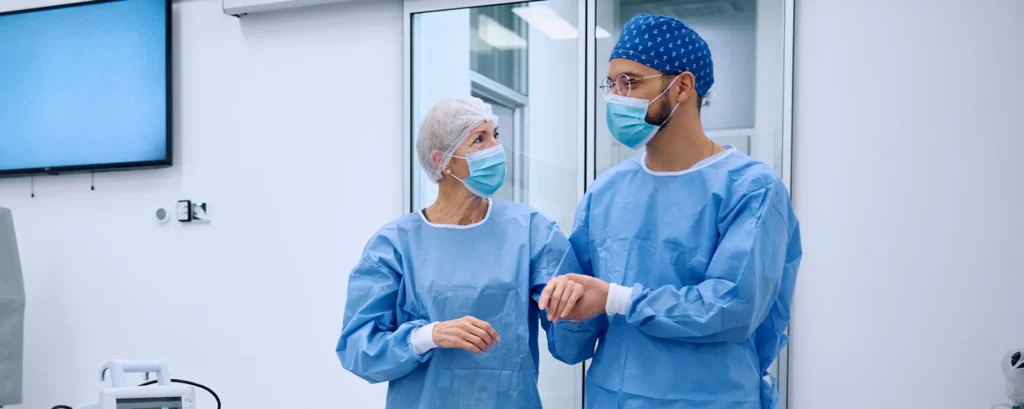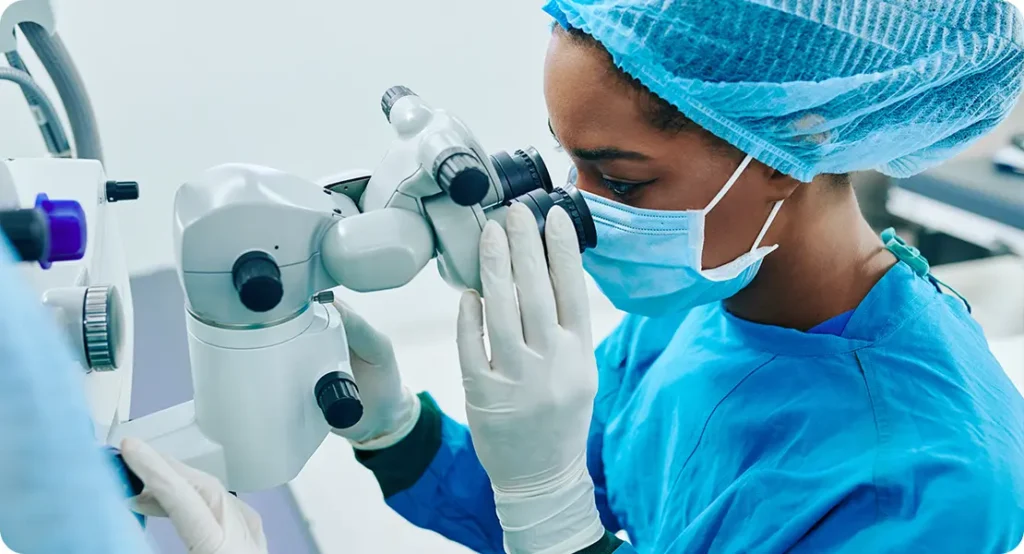If you’ve been told you have cataracts and early signs of Fuchs’ dystrophy—or maybe just corneal guttae—you’re probably feeling a mix of confusion and concern. Cataract surgery on its own is already a big decision. But throw in a potentially compromised corneal endothelium, and the situation becomes a bit more complex.
So, let’s break it all down together. We’ll go through what guttae and Fuchs’ really mean, how they affect your cornea, what extra considerations your surgeon needs to take during cataract surgery, and when a combined or staged endothelial transplant—like DMEK or DSAEK—might come into play.
What Are Corneal Guttae and Fuchs’ Dystrophy?
- Understanding the Basics
Corneal guttae are essentially little bumps that form on the innermost layer of the cornea, known as the endothelium. These bumps are often the first visible sign of a condition called Fuchs’ endothelial dystrophy—a slow, progressive disease where the endothelial cells gradually deteriorate. These cells are vital for keeping your cornea clear by pumping out excess fluid. - Guttae Alone vs Fuchs’
It’s important to understand that not everyone with guttae has Fuchs’. Guttae can be age-related and totally asymptomatic. But when they start to spread and you notice glare, blurred vision in the morning, or haziness that improves throughout the day, you might be sliding into early Fuchs’ territory. - Why This Matters Before Cataract Surgery
Here’s the catch: cataract surgery puts stress on your corneal endothelium. If it’s already weakened, you’re at a higher risk of corneal decompensation post-op. That’s why early detection and clear surgical planning are critical when guttae or early Fuchs’ are involved.
How Cataract Surgery Stresses the Cornea
- Mechanical and Ultrasound Impact
During phacoemulsification—the most common technique for cataract removal—ultrasound energy is used to break up and remove the lens. This process creates heat, turbulence, and physical stress, all of which can damage the fragile endothelial cells lining your cornea. - Endothelial Reserve Is Key
The average healthy cornea has about 2,500 to 3,000 endothelial cells per square millimetre. When that number dips below 1,000, the risk of permanent corneal swelling and loss of transparency skyrockets. People with Fuchs’ or significant guttae often start off with lower numbers, meaning there’s less margin for error during surgery. - Long-Term Impact
Even if the surgery goes smoothly, there’s a risk of delayed corneal decompensation. Your vision might be fine for months—or even a year—but then slowly start to blur again as the endothelial reserve dwindles. That’s why some surgeons may plan for an endothelial transplant down the line, even if your cornea looks “okay” for now.
Preoperative Evaluation: What to Expect
- Specular Microscopy
This imaging test gives your surgeon a count of your endothelial cells and shows their shape and size. A low count or many irregular cells (polymegathism and pleomorphism) signals trouble ahead. - Pachymetry
A thicker-than-normal cornea—especially centrally—can be an early warning sign of endothelial dysfunction. Pachymetry helps your surgeon assess whether swelling is already underway. - Corneal Topography and Tomography
While topography maps the front surface of the cornea, tomography can reveal changes deeper within the cornea, including subclinical oedema that may not be visible under the microscope. - Patient Symptoms
Don’t downplay your symptoms. Morning blur that improves later in the day is a classic sign of early Fuchs’. Let your surgeon know about it—it might affect whether they do cataract surgery alone or plan for an additional procedure.
Intraoperative Strategies to Protect the Endothelium
- Viscoelastic Choice Matters
Your surgeon will likely use a dispersive viscoelastic (like Viscoat or EndoCoat) that clings to the cornea and provides a cushion against ultrasound energy and fluid turbulence. These substances are specifically designed to protect your fragile endothelium during surgery. - Reducing Phaco Time and Energy
The less ultrasound used, the better. Surgeons may use techniques like “phaco chop” or “stop-and-chop” to minimise the energy required. They may also soften the cataract with femtosecond lasers beforehand if available. - Avoiding Fluid Overload
Balanced salt solution (BSS) is used to irrigate the eye during surgery, but too much fluid or too high a pressure can damage the endothelium. Experienced surgeons know how to strike the right balance.

Choosing the Right Intraocular Lens (IOL)
- Avoiding Multifocal Lenses in Early Fuchs’
Multifocal and extended depth of focus (EDOF) lenses split incoming light into multiple focal points. In eyes with endothelial compromise, where there may already be glare, contrast sensitivity issues, or hazy vision, these lenses can make things worse. - Monofocal or Monovision Options
Monofocal lenses, which provide clear vision at one focal distance, are usually the safest bet. Some patients opt for monovision—one eye corrected for distance and the other for near—to reduce dependence on glasses while avoiding the pitfalls of multifocals. - Toric Lenses for Astigmatism
If you have corneal astigmatism and your cornea is stable, toric IOLs can still be used. However, in Fuchs’, this must be evaluated carefully because future endothelial transplants can change corneal curvature.
When Is DMEK or DSAEK Needed?
Staged vs Combined Procedures
There are two main strategies if your cornea is at risk:
- Staged approach: Cataract surgery first, then corneal transplant later if needed.
- Combined approach (triple procedure): Cataract surgery, IOL insertion, and endothelial transplant (usually DMEK or DSAEK) done in one sitting.
Each approach has pros and cons. Combined surgery shortens recovery time and avoids two anaesthetics, but it requires more surgical skill and planning. A staged approach gives a clearer picture of how your cornea will respond to cataract surgery alone.
DMEK vs DSAEK
- DMEK (Descemet Membrane Endothelial Keratoplasty) transplants only the endothelium and Descemet’s membrane. It’s thinner, provides better vision outcomes, but is technically more demanding.
- DSAEK (Descemet Stripping Automated Endothelial Keratoplasty) includes a small layer of donor stroma. It’s easier to handle but may result in slightly thicker grafts and slower recovery.
DMEK is increasingly preferred for early Fuchs’ because it mimics the natural cornea more closely.
Timing Is Everything
If you already have symptoms of Fuchs’ and a low endothelial count, it’s often better to plan a triple procedure from the start. If you’re asymptomatic with minimal guttae, cataract surgery alone with precautions might be enough—for now.
Postoperative Care and Monitoring
- Close Follow-Up
Patients with Fuchs’ or guttae need closer monitoring after cataract surgery than average. Expect more frequent appointments in the first few weeks, and ongoing checks of your corneal clarity for months. - Signs of Decompensation
Watch for persistent blur, especially in the morning, or increasing glare and halos. These might be early signs of decompensation. Don’t ignore subtle changes—report them promptly. - Long-Term Risk
Remember, Fuchs’ is progressive. Even if your surgery goes well, the underlying disease may continue. At some point, you may still need a DMEK. But delaying it safely is still a win.

Frequently Asked Questions
1. Can I still have cataract surgery if I’ve been diagnosed with early Fuchs’ dystrophy?
Yes, you absolutely can—but the approach needs to be carefully tailored. Early Fuchs’ dystrophy means your corneal endothelium is already showing signs of stress, so your surgeon will need to factor that into both the surgical plan and the choice of intraocular lens (IOL). What matters most is the extent of endothelial cell loss and whether you’re currently experiencing symptoms like blurred vision or morning haze.
Your preoperative assessment will likely include specular microscopy to measure cell counts and pachymetry to look for swelling. If your cell count is still relatively healthy, cataract surgery alone may be sufficient—especially if it’s performed using protective techniques and dispersive viscoelastic agents. Many people with early-stage Fuchs’ have successful cataract surgery outcomes without requiring a corneal transplant.
However, if your symptoms are progressing or your tests suggest significant endothelial compromise, your surgeon may recommend a combined approach. This could include a Descemet membrane endothelial keratoplasty (DMEK) or Descemet stripping automated endothelial keratoplasty (DSAEK) at the same time as cataract removal. These transplant procedures replace the damaged endothelial layer to maintain long-term corneal clarity.
The key takeaway is that early Fuchs’ isn’t a deal-breaker—it just means more care and planning are involved. It’s vital that your surgeon has experience managing cataracts in the context of corneal disease, as the timing, technique, and follow-up will need to be more precise.
2. What are corneal guttae, and do they always mean I have Fuchs’ dystrophy?
Corneal guttae are small wart-like excrescences that appear on the inner surface of your cornea, specifically on the Descemet membrane. They’re often detected during a routine eye exam and can be completely asymptomatic, particularly in older adults. Not everyone with guttae goes on to develop Fuchs’ dystrophy, which is a more advanced condition involving progressive endothelial cell loss.
In many cases, especially when the guttae are sparse and not affecting vision, no immediate treatment is needed. However, their presence can be a red flag. That’s because guttae are considered the earliest clinical sign of Fuchs’ dystrophy—even if you don’t yet have symptoms like morning blur, glare, or fluctuating vision. Think of them as a possible precursor, not a diagnosis in themselves.
If you’ve been told you have guttae and are planning to have cataract surgery, it’s a good idea to undergo additional testing. Specular microscopy can assess whether the remaining endothelial cells are still functioning well. Your ophthalmologist might also perform corneal thickness measurements and look for any subtle signs of oedema that may not yet be visible to the naked eye.
In short, guttae alone aren’t a guarantee that you’ll develop Fuchs’, but they do warrant a closer look—especially before cataract surgery. Being proactive with early assessments can help you avoid complications and ensure any surgical interventions are timed just right.
3. Should I have cataract surgery and a corneal transplant done at the same time?
That depends on several factors, including your symptoms, test results, and overall eye health. If you already have signs of corneal swelling or a very low endothelial cell count, combining cataract surgery with an endothelial transplant (like DMEK or DSAEK) may be the most efficient and safest route. This is often referred to as a “triple procedure,” where cataract removal, IOL placement, and corneal grafting are done in a single operation.
There are definite advantages to this approach. It avoids putting your eye through two separate procedures and shortens the total recovery time. The visual rehabilitation may also be smoother since the graft and IOL can work in tandem from the start. However, not all patients are suitable candidates for a combined surgery—it requires precision, skill, and careful timing, particularly in how the graft behaves postoperatively.
On the other hand, if your guttae or early Fuchs’ changes are mild, your surgeon might opt for a staged approach instead. This involves doing the cataract surgery first, using special techniques to protect your endothelium, and then waiting to see how your cornea recovers. If decompensation develops later, the transplant can be done as a secondary procedure. This route avoids unnecessary transplant surgery if your cornea holds up well after cataract removal.
Ultimately, this decision should be made on a case-by-case basis. Your ophthalmologist will weigh the pros and cons based on your specific corneal condition and visual goals. It’s worth asking how many combined procedures your surgeon has performed and what their outcomes have been.
4. What intraocular lens (IOL) is best if I have early Fuchs’ dystrophy?
If you’re dealing with early Fuchs’ or significant guttae, your best bet is usually a monofocal IOL. These lenses provide clear vision at one set distance—usually for far vision—and have the least impact on contrast sensitivity and night vision. Since Fuchs’ can already affect visual clarity, it’s best not to introduce additional optical compromises.
Multifocal and extended depth of focus (EDOF) lenses might seem appealing—after all, who wouldn’t want to reduce dependence on glasses? But these lenses split light into multiple focal points, which can amplify glare and reduce contrast. In eyes already struggling with early corneal haze or irregularities, these effects can be even more pronounced and frustrating.
Toric lenses are still an option if you have regular astigmatism and your corneal curvature is stable. That said, if a future DMEK or DSAEK is likely, the corneal shape might change post-transplant, potentially affecting the accuracy of the astigmatism correction. Your surgeon might err on the side of caution and choose a standard monofocal lens, with glasses used to correct any residual astigmatism after surgery.
It’s important to be open about your lifestyle and visual preferences during your pre-surgical consultation. Are you happy to wear reading glasses? Do you drive at night? Do you value clarity above all else? These answers help your surgeon make a choice that balances safety with satisfaction—especially when corneal health is part of the equation.
Final Thoughts
If you’ve got cataracts and signs of corneal guttae or early Fuchs’ dystrophy, you’re not alone—and you’ve got options. This isn’t a one-size-fits-all situation. The right approach depends on how advanced your corneal condition is, what your visual goals are, and what your surgeon finds during your preoperative assessment.
Your job is to be informed and proactive. Ask your surgeon about your endothelial cell count. Discuss the risks of surgery, and what intraoperative protections they plan to use. Don’t shy away from questions about IOL choice or the possibility of a future transplant.
Modern ophthalmology has come a long way. With careful planning and the right expertise, you can have cataract surgery safely—even with corneal compromise. If you’re thinking about going down the route of private cataract surgery in London with a trusted specialist team, now is the perfect time to explore your options.
References
- Gain, P., Jullienne, R., He, Z., Aldossary, M., Acquart, S., Cognasse, F. and Thuret, G., 2016. Global survey of corneal transplantation and eye banking. JAMA Ophthalmology, 134(2), pp.167–173.
- Price, M.O., Price, F.W., Benetz, B.A., Lass, J.H., Shukla, S.Y., Ing, J.J., and Menefee, R.L., 2016. Descemet’s membrane endothelial keratoplasty: Risk factors and outcomes for 1000 consecutive eyes. American Journal of Ophthalmology, 161, pp.8–14.e1. https://doi.org/10.1016/j.ajo.2015.09.025
- Okumura, N., Kinoshita, S. and Koizumi, N., 2014. The role of oxidative stress in Fuchs endothelial corneal dystrophy: Insights from laboratory research. Cornea, 33(Suppl 11), pp.S57–S60. Available at: https://journals.lww.com/corneajrnl/Fulltext/2014/11001/The_Role_of_Oxidative_Stress_in_Fuchs.11.aspx [Accessed 2 Jun 2025].
- Zygoura, V., Diakonis, V.F., Kanellopoulos, A.J., and Melles, G.R.J., 2022. Cataract surgery in eyes with Fuchs endothelial corneal dystrophy: Current perspectives. Clinical Ophthalmology, 16, pp.2763–2771. Available at: https://www.dovepress.com/cataract-surgery-in-eyes-with-fuchs-endothelial-corneal-dystrophy-c-peer-reviewed-fulltext-article-OPTH [Accessed 2 Jun 2025].
- Patel, S.V. and Bourne, W.M., 2009. Corneal endothelial cell changes after cataract surgery: Current understanding and future directions. Ophthalmology, 116(7), pp.1228–1235.

